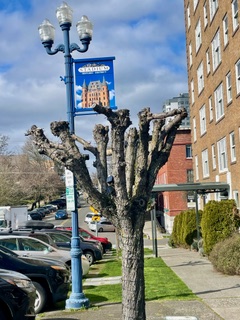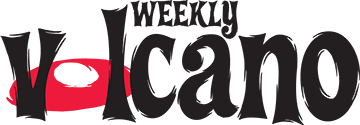Growing Green: Tacoma’s Struggle to Protect and Plant Trees
BY TOM GISKE for Weekly Volcano
We are beginning to hear so many good things about trees in our neighborhoods.
The Tacoma Tree Foundation has raised more money than it thought possible, continues to expand its urban forest programs, and is planting more than 5,000 trees annually, with a focus on our most underserved neighborhoods.
The Pierce Conservation District gives grants to homeowners to reduce impervious space and install rain gardens.
Mike Carey, our Urban Forest Program Manager, after getting our City Council to pass its first tree ordinance in more than 100 years—protecting trees on public property and creating a Heritage Tree Program—continues to expand his outreach programs with local volunteer groups to plant more trees.
The City of Tacoma is hiring arborists to monitor the new tree ordinance and to ensure development projects protect existing trees—or plant replacements when that is not possible.
The City’s Environmental Services Department, in its execution of the City’s Stormwater Management Plan, has finally included the need to use trees and natural infrastructure to help prevent stormwater runoff.
We hear from Public Works Director Ramiro Chavez that his department has a new mindset: trees around utility lines will be properly pruned, street and sidewalk projects will prioritize tree preservation, and if Street Initiative II passes, it will include “complete streets”—designed for comfortable and safe walking among trees.
Council Member Sarah Rumbaugh (District 2) sponsored a successful amendment to Home in Tacoma that now requires a legitimate permit to remove any tree larger than 24 inches in diameter on private property. She has also declared 2025 the Year of the Tree in Tacoma.
Council Deputy Mayor John Hines, now running for mayor, sponsored another successful amendment to Home in Tacoma, which the Infrastructure, Planning, and Sustainability Committee is now using to create a comprehensive program to protect and expand our tree canopy on non-development sites.
Pierce County Executive Ryan Mello, who sponsored our Urban Forest Management Plan when he was on the Tacoma City Council in 2019 (though it remains unfunded), says we must invest in trees—or climate change will diminish our lifestyle in the South Sound.
And on and on it goes.
Yet nearly every day, we see big trucks with crane buckets lifting butchers with chainsaws into the upper crowns of our largest trees, topping them or removing them entirely. Sometimes it’s for legitimate reasons, but more often, it’s simply because the owner or developer doesn’t want to deal with it.
Perhaps it is time we ask: Why do we have trees? They live in areas based on climate. Where there is rain, there are trees. Where there is more rain, there are more trees. Trees disperse rain and help the ground absorb it. Maybe that’s one reason we have trees.
They keep stormwater and pollutants out of our waterways. Their roots work better than pipes—allowing salmon to lay their eggs safely in rivers and streams, which feeds our Orca pods and sustains our food chain—until we interfere by cutting down more trees.
Do we understand the value of trees? Once a tree reaches 10 to 15 feet tall, it begins to create value for neighboring parcels—and as it grows, its benefits extend to the entire city.
It cools its surroundings in the summer. It lessens the impact of storms in the winter. It removes carbon from the air and replaces it with oxygen (Now, why would such a process exist if it wasn’t intended to ensure our public health?) It provides a home for wildlife—who, in turn, control pests and bad organisms that harm us.
And the list goes on and on.
Yet our number of trees continues to diminish.
So, while our public officials continue their good work, the actual number of trees in Tacoma keeps shrinking.
Perhaps we need a ballot measure for voters to decide: Should we invest in our urban forest?
Are we planning on growth without trees? If so, many of us will end up moving elsewhere—to Snoqualmie, Vancouver, or Portland—where trees are seen as community assets to cherish and preserve.
The Best (Worst) Way to Kill a Tree

BY MELANIE MOOR for Weekly Volcano
The worst thing you can do to a tree is “top” it. Topping a tree means removing more than 25% of its crown (top) during pruning. It involves indiscriminately cutting branches down to stubs—a common practice despite the well-established fact that it’s detrimental to the tree’s health. The City of Tacoma officially classifies topping as a “non-acceptable pruning practice” and prohibits it.
Why Is Topping So Harmful? When you top a tree, it reacts by sending out fast-growing water sprouts—small, brittle branches that break easily and weaken the tree.
Topped branches are more vulnerable to pests and decay. The new weakly attached branches increase storm damage risk and liability. The tree’s overall health declines, making it more susceptible to disease and failure.
Why Does This Matter? Tacoma needs trees. We have the lowest tree canopy in Western Washington—only 20% coverage!
For comparison:
– Seattle has 28% canopy
– Kent has 28% canopy
– Olympia has 42% canopy
Tacoma’s Tree Canopy Goal: Are We on Track? Five years ago, the Tacoma City Council set a goal to increase tree canopy to 30% by 2030.
Unfortunately, we haven’t planted nearly enough trees in these past five years to make a significant impact.
The Tacoma Tree Foundation (TTF), a nonprofit dedicated to growing Tacoma’s urban forest, plants over 5,000 trees annually—a remarkable effort, but far from the million trees needed to reach 30% canopy coverage.
A Critical Time for Tacoma’s Tree Plan
The Infrastructure, Planning, and Sustainability (IPS) Committee is currently discussing how to achieve Tacoma’s 30% tree canopy goal.
Soon, we’ll have results from a LIDAR study—a remote sensing technology used to map Tacoma’s tree coverage. This will help identify where trees are needed most.
Restoring Forest—One Tree at a Time
Tacoma was once a vibrant forest but 150 years ago, the timber industry logged the entire area—with no thought for replanting. Today, planting a million trees—for both human survival and the health of all life forms—is an investment we can’t afford to delay.
Equally important? Caring for the mature trees we already have.
Together, one tree at a time, let’s Make Tacoma Green Again!
Want to get involved? Visit the City of Tacoma’s website to learn how to voice your ideas and concerns.
Get Involved
Tacoma Tree Foundation:
www.tacomatreefoundation.org
City of Tacoma Urban Forestry:
www.cityoftacoma.org/cms/One.aspx?portalId=169&pageId=13050
City of Tacoma Street Tree Pruning Standards: www.cms.cityoftacoma.org/enviro/urbanforestry/cot%20street%20tree%20pruning%20standards.pdf
